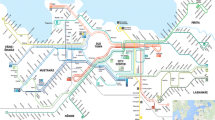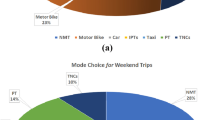Abstract
Ridesharing is quite a popular topic of discussion among transport authority personnel. It is perceived to be a viable alternative to classical modes of transportation, and receives a great deal of political support from transport planners. However, not much objective information is available on ridesharing behaviors. We use travel survey data to study the evolution of the ridesharing market in an urban area. Our study is based on data from four large-scale OD surveys conducted in the Greater Montreal Area (1987, 1993, 1998 and 2003).
In the latest survey conducted in Montreal, car passengers were asked to identify the driver who gave them the opportunity to travel in this way. Their answers were classified according to the type of driver; for instance, a member of their household, a neighbor or a co-worker. We use this information to calibrate a model matching car passengers and car drivers belonging to the same household. This will be referred to as IHHR (intra-household ridesharing).
Preliminary results reveal that approximately 70% of all trips made by car passengers are the result of IHHR. Furthermore, around 15% of those trips are questionable, in that they were exclusively generated for another individual’s purposes, consequently generating an additional trip for the journey back home. Moreover, this percentage increased over time. Objective data regarding ridesharing and its evolution in an urban area will undoubtedly help decision makers gain a clearer profile of this means of travel and help to realign attitudes on the issue.






Similar content being viewed by others
Notes
Trips combining car passenger and transit (KR).
Trips combining a car drive and public transit (PR).
References
Baldassare, M., Ryan, S., Katz, C.: Suburban attitudes toward policies aimed at reducing solo driving. Transportation 25, 99–117 (1998)
Black A.: Urban Mass Transportation Planning. McGraw Hill, 411 pp (1995)
Collura, J.: Evaluating ride-sharing programs: Massachusetts’ experience. J. Urban Planning Devel. 120(1), 28–47 (1994)
Dailey, D.J., Loseff, D., Meyers, D.: Seattle smart traveler: dynamic ridematching on the World Wide Web. Transport. Res. Part C 7, 17–32 (1999)
Fellows, N.T., Pitfield, D.E.: An economic and operational evaluation of urban car-sharing. Transport. Res. Part D 5, 1–10 (2000)
Ferguson, E.: The rise and fall of the American carpool: 1970—1990. Transportation 24, 349–376 (1997)
Gliebe, J., Koppelman, F.S.: A model of joint activity participation between household members. Transportation 29, 49–72 (2002)
Gliebe, J., Koppelman, F.S.: Modelling household activity—travel interactions as parallel constrained choices. Transportation 32, 449–471 (2005)
Golob, J.M., Giuliano, G.: Smart traveler automated ridematching service lessons learned for future ATIS initiatives. Transport. Res. Record, 1537, 23–29 (1996)
Higgins, T.J., Johnson, W.L.: Evaluating transportation programs: neglected principles. Transportation 26, 323–336 (1999)
Huwer, U.: Public transport and car-sharing—benefits and effects of combined services. Transport Policy 11, 77–87 (2004)
Loukopoulos, P., Jakobsson, C., Gärling, T., Meland, S., Fujii, S.: Understanding the process of adaptation to car-use reduction goals. Transport. Res. Part F 9, 115–129 (2006)
Mackett, R.L., Lucas. L., Paskins, J., Turbin, J.: The effectiveness of initiatives to reduce children’s car use, Proceedings of the European Transport Conference, held in Strasbourg, France, October 2003
Miller, E.J., Roorda, M.J., Carrasco, J.A.: A tour-based model of travel mode choice. Transportation 32, 399–422 (2005)
Pisarski, A.E.: Carpooling: past trends and future prospects. Transport. Q. 51(2), 6–9 (1997)
Salomon, I., Mokhtarian, P.L.: Coping with congestion: understanding the gap between policy assumptions and behavior. Transport. Res. Part D 2(2), 107–123 (1997)
Shaheen, S.A.: Commuter-based car sharing: market niche potential. Transport. Res. Record, 1760, 178–183 (2001)
Teal, R.F.: Carpooling: who, how and why? Transport. Res. 21A(3), 203–214 1987)
Wright, C., Curtis, B.: Reshaping the motor car. Transport Policy 12, 11–22 (2005)
Acknowledgments
The author wishes to acknowledge the institutions that continuously collect valuable data on travel behaviors through OD surveys. These large-scale processes contribute to the advancement of transportation models and methods: STM, RTL, STL, AMT and MTQ.
The author especially acknowledges the AMT (Metropolitan Transportation Agency), which supports the study of critical analytical issues related to urban transportation, notably the multimodal trips and ridesharing behaviors.
Author information
Authors and Affiliations
Corresponding author
Rights and permissions
About this article
Cite this article
Morency, C. The ambivalence of ridesharing. Transportation 34, 239–253 (2007). https://doi.org/10.1007/s11116-006-9101-9
Published:
Issue Date:
DOI: https://doi.org/10.1007/s11116-006-9101-9




